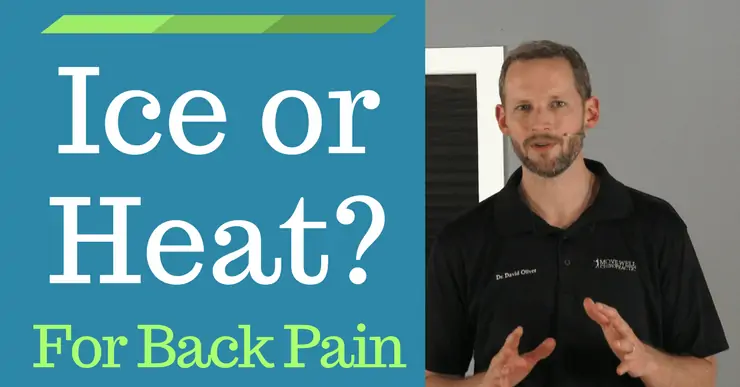
If you suffer from Back pain, applying ice and heat to the area can help to decrease your back pain and speed up your healing. Watch the video to learn when to apply ice or heat for back pain relief:
Ice and heat therapy are readily available, affordable and effective for many injuries, which makes them a popular choice when you’re having back and neck pain.
However, using them incorrectly, or at the wrong time, can actually worsen your condition.
We’re going to discuss ice and heat, and explain the differences between the two as well as when you should be using each therapy.
When to use ice or heat for back pain and why
The most important factor to keep in mind when using ice and heat on an injury is blood flow.
Ice
– Reduces blood flow by constricting blood vessels.
Heat
– Encourages blood flow by dilating blood vessels.
When you want to decrease inflammation to an area, you want to reduce blood flow and therefore ice should be used.
On the other hand, if you want to increase blood flow to an area to encourage healing, you want to use heat.
Timing of ice and heat application is critical, because using them at the wrong time can actually worsen your condition.
For example, if you suffer an acute lower back injury and fall asleep on a heating pad, you’re likely going to feel increased pain and have difficulty moving. This will happen because you’ve used heat at the wrong time and for the wrong amount of time – you should have been using ice.
Remember, there is a time for each of these therapies, and occasionally using both can be beneficial as well.
It’s important that you know when and why to apply ice and/or heat to your injury to help improve your condition, and prevent your injury from getting worse.
When to use ice for back pain?
You’ll want to apply ice during the acute phase, or inflammatory phase, of a back injury (Or Pulled muscle). Generally speaking, the inflammatory phase is the first 72 hours following an injury.
If you suffer an acute injury, your body responds in the following ways:
– Increased inflammation.
– Increased blood flow to the area.
– Increased swelling.
– Increased pain.
By applying ice during the inflammatory stage you help to:
– Reduce inflammation.
– Reduce pain.
– Increase your healing speed.
Guidelines for applying ice therapy:
– 20 minutes at a time, followed by a 40 to 60 minute break.
* Note: If you ice for longer period of time, you’ll actually have a negative response. Your body does the opposite of what you’re trying to do. This means that instead of constricting blood flow to decrease inflammation to the area, your body will dilate blood vessels, which will increase blood flow to the area, thereby increasing inflammation and pain.
– During the first 72 hours, you can use ice multiple times during the day (5 to 6 times a day for a severe injury, separated by 1-2 hour breaks).
– Never apply ice directly to skin; always use a barrier between your skin and ice such as a thin towel or shirt to prevent frostbite.
Ways to apply ice therapy to an injured area at home include:
– Ice packs.
– Ice massage.
– Ice baths.
– Coolant sprays.
Sensations you will feel from icing include:
– Cold
– Burning
– Aching
– Numbing (This is the most important phase for decreasing your pain and inflammation and is felt at the end of the 20-minute application of ice).
When to use heat for back pain?
After the inflammatory phase, the first 72 hours, you can start to introduce heat to the situation in most cases. However, in some cases, even after the first 72 hours, it’s still too early for heat. If you continue to have sharp pain, or have pain that radiates down your leg, do not use heat, it’s too early and you should continue to ice until these symptoms subside.
Generally speaking, heat is good option for chronic or long-term issues that present with dull and achy pain, as well as muscle tightness. Heat helps to increase pliability of tightened muscles and increases your flexibility, which in turn helps to decrease your pain and improve function.
As a general rule, you want to use heat for about 30 minutes at a time. Anything longer than 30 minutes, and you may start to notice increased inflammation and pain.
There are two different types of heat therapy: Dry heat and Moist heat.
Dry heat (conducted heat therapy)
– Easy to apply.
– Includes heating pads and dry heat packs.
Moist heat (convection heat therapy)
– slightly more effective than dry heat, takes less time, however, it’s more difficult to apply.
– Includes moist heat packs, steamed towels, and hot baths.
When to use both Heat & Ice? Called: Contrast Therapy
You can use ice and heat separately, or in some cases, together, which is known as contrast therapy. The key to contrast therapy is to start with heat and finish with ice. This has to do with the dilation and constriction of blood flow to the injured area.
You want to start with dilating the blood vessels with heat, followed by constriction of blood vessels with the ice. This works to create a pumping effect. which promotes healing of the area. Contrast therapy is generally used after the first 72 hours, before you start to apply heat on its’ own.
When NOT to use either?
There are some cases when you should avoid using ice or heat including:
– Do not apply heat or ice to open wounds.
– Do not use ice if you have circulatory issues or if you use blood thinners.
– Do not apply ice or heat if you sensation issues (i.e. peripheral neuropathy, diabetic neuropathy).
In Conclusion
Ice and heat can help to reduce inflammation and back pain, and improve healing of an injury if they are used correctly.
Related:
Pulled muscle in low back treatments
Pulled muscle in upper back treatments
Self massage techniques
Cobra Pose for beginners (Low back pain stretch)
How ease back pain naturally
Sources:
https://journals.lww.com/nsca-jscr/Abstract/2015/11000/Cold_Vs__Heat_After_Exercise_Is_There_a_Clear.33.aspx
https://www.ncbi.nlm.nih.gov/pmc/articles/PMC4225921/
health.clevelandclinic.org/should-you-use-ice-or-heat-for-pain-infographic/
http://jaoa.org/article.aspx?articleid=2092892
Dr. Oliver has been practicing in Massachusetts since 2007. He is a graduate of Marist College where he received a Pre-Med Bachelor of Science degree in Biology. Dr. Oliver then went on to pursue his chiropractic career by attending Palmer College of Chiropractic West, where he graduated Cum Laude. Dr. Oliver has his diploma in rehabilitation, which allows him to combine rehab and corrective exercise with traditional chiropractic treatment. This gives his patients better long term results.

